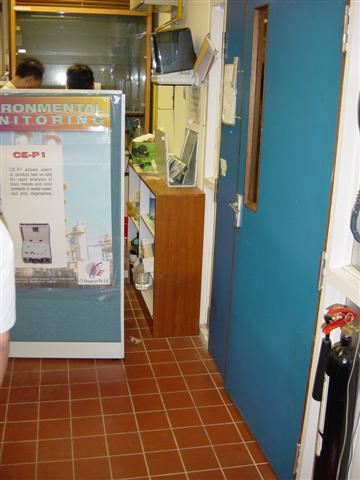General Housekeeping
- Glassware (including glass chemical containers) should not be left on the floor
- All chemical containers in the lab should be labeled, especially in the fridge and fume hood
- Avoid using round bottom flasks for storage of compounds. This is especially important where the fridge is concerned. Upon opening the door, they may roll out and break on the floor resulting in the release of toxic chemicals that may be stored in them.
- Keep all aisles, walkway and exits clear to provide a safe walking surface and an unobstructed exit.
- Do not block access to emergency equipment and utility controls e.g. main switches, gas valves, etc.
- Keep the work surface as uncluttered as possible.
Handling Mercury Spills
- Clean up all mercury spills promptly.
- If a large area is involved, obtain sulphur from Laboratory Supplies and spread it over the area. After 24 hours sweep up the sulphur. Place mercury and sweepings in a container and arrange for disposal.
- When a mercury spill is not cleaned up promptly it may be ground into the floor, fracturing into extremely small particles with a large total surface area (6.4 ft3 for 1 ml as 10 micron spheres). From such large areas, mercury may vaporize at a rate faster than the room’s ventilation can safely dilute it.
- The rate of mercury volatilization is directly related to temperature. Whenever elevated temperatures are involved, special care must be exercised to provide adequate ventilation. A common occurrence is the breaking of thermometers due to bumping or raising the temperature above the thermometer’s capacity.
In addition to handling mercury spills, All staff and students are reminded to exercise extreme caution when handling organomercury compounds. Karen E. Wetterhahn, Professor of Chemistry and Albert Bradley Third Century Professor in the Sciences at Dartmouth College, died June 8, 1997 at the age of 48 from mercury poisoning. The cause of the poisoning has been traced to several drops of dimethylmercury which seeped through latex gloves. More details can be found at the links below:
ACS Chemical & Engineering News: Safety Letters on
All staff and students are advised to read the prepared risk assessment on Handling Acutely Toxic Compounds as well as the above links.
Liquid Nitrogen
- Liquid nitrogen is frequently used in chemical research laboratories for the purpose of cooling because of its low boiling point (bp -196 °C), inexpensive price, and low toxicity.
- Cryogenic liquids such as liquid nitrogen can cause very severe burns upon eye or skin contact.
- Splashes are common when handling liquid nitrogen and safety goggles and gloves must therefore be worn at all times when working with this material.
- Do not use household thermos bottles as a substitute for laboratory Dewar flasks. Their walls are too thin and they are not designed to withstand the low temperature.
- Extreme care must be employed when using liquid nitrogen as a cold trap coolant. Systems including liquid nitrogen traps must never be opened to the atmosphere until the trap is removed from the coolant. Oxygen has a higher boiling point (-183 °C) than nitrogen ( 196 °C), and will condense out of the atmosphere and collect in a liquid-nitrogen cooled vessel open to the air. Liquid oxygen forms highly explosive mixtures with many organic materials.
- Never cool an apparatus that is under an argon atmosphere using liquid nitrogen. Argon will condense at liquid nitrogen temperature and when the apparatus is removed from the coolant, liquid argon will instantly vaporize, expanding in volume by a factor of 847! Even if the vessel is vented (e.g. to an inert gas line), an explosion is very likely due to the rapid increase in pressure in the vessel.
Quenching of Reactives
This must be performed in a fume hood in the absence of water or solvents as they may result in an uncontrollable fire or even an explosion.
a) Sodium
- Quenched by adding sodium slowly to a large bucket of isopropanol (preferred) or ethanol. Very often, the sodium is coated with decomposed organic compounds (e.g. benzophenone). Treat all lumps of organic material as sodium-containing matter and break them up in the alcohol carefully. Before disposing of the quenched material in the bucket, add an equal amount of ice to it and let it stand overnight before pouring it down the sink.
b) CaH2, LiAlH4, NaH and other metal hydrides
- Quenched by adding them to an ice/water mixture with stirring. If the hydride is in powder form, beware of the fine dust particles which will rise into the air during the quenching (especially CaH2). Wear a face mask in these cases.
When washing a flask with unknown contents, DO NOT ADD WATER DIRECTLY TO THE FLASK. It might contain substances which react violently with water.
Visually check the flask for:
a) metallic Sodium
b) metal Hydrides
Follow the procedures given above for quenching these reactive substances if you suspect they are present.
Examples of bad practices

Unlabelled Chemical containers in Fumehood

Unsupported RBF used to store chemicals in fridge

Obstructed access to exit

Breakable glass chemical containers on the floor

Improper Storage of Chemicals, Glassware and Equipment.




